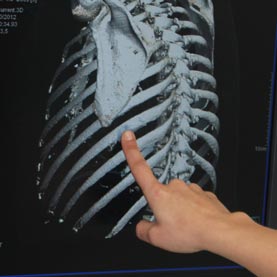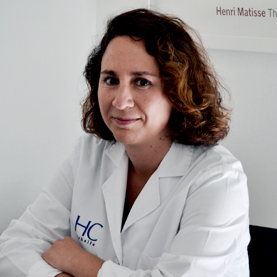
Osteoporosis is a disease that causes a decrease of the bone density turning the bones weak and frail and prone to fractures.
In technical terms, osteoporosis is a “Decrease in the bone mass per volume unit“. The spongy bone becomes less dense with bigger spaces forming between the bony structure of struts, which also become thinner. On a radiologic image this shows greater transparency. This loss of spongy or cancellous bone causes fractures in the vertebras and the loss of the cortical bone causes fractures in long bones.
Osteoporosis is often called a “silent disease” because in many cases people aren’t aware that they have it until they have a minor fall that causes a bone to break.
Nowadays over 3 million people in Spain have osteoporosis out of which 2,5 million are female and only 18% have been diagnosed.
To evaluate the stage of this disease we can perform a Bone Densitometry (BMD), a study that measures the bone mineral density and compares it to the peak bone mineral density of a healthy 30-year-old adult (T score).
Depending on the values we can identify the particular situatuion of each patient:
There are different forms of osteoporosis:
PRIMARY OSTEOPOROSIS: Associated to the aging process. There are various types depending on the age and we can differenciate them into two subtypes:
-Type I: postmenopausal (51-74 years): More frequent in women, associated to hormonal changes during menopause.
-Type II: senile (>71 years): Incidence 2:1, more frequent in women and it is associated to aging.
SECONDARY OSTEOPOROSIS: Is caused by an alteration of the metabolic bone due to endocrine, gastrointestinal, metabolic, hematological, neoplastic diseases as well as the intake of certain medicines, etc.
Different factors augment the risk to suffer from osteoporosis. They are categorized as:
| RISK FACTORS FOR OSTEOPOROSIS | |
| NON MODIFIABLE | MODIFIABLE |
| Age | Underweight (BMI < 10KG / m2) |
| Gender (female) | Sedentary lifestyle |
| Genetics | Low calcium intake |
| Menopause | Protein diet |
| Hypogonadism | Tobacco smoking |
| Diseases | Alcohol and coffee abuse |
| Endocrinology: Cushing Syndrome, primary hyperparathyroidism, hyperthyroidism | Medical treatments with: |
| Rheumatic: rheumatoid arthriti | Corticosteroids |
| Nutritional: malnutrition, anorexia nervosa | Immunosuppressants |
| Digestive celiac disease, severe liver disease | Anticoagulants |
| Neoplasm: multiple myelome | Heparin |
Prevention of Osteoporosis:
The preventions consist majorly in modifying the factors that accelerate the physiological loss of bone mass in an adult (secondary) and in reducing the risk of the complications inherent to the disease which, in the case of osteoporosis, are fragility fractures (tertiary).
Who should have a Bone Density Test?
Women with clear osteoporosis risk (previous fracture, early menopause, underweight, etc.), people with a history of fractures due to fragility, in case of suspicion of secondary osteoporosis after the intake of corticosteroids during 3 or more months, or in case any of any of the previously mentioned risk factors.

At HC Marbella we have an osteoporosis area that consists of medical specialists in traumatology, endocrinology, intern medicine, nutrition, gynecology, orthopedic surgery, nuclear medicine and radiology, with the common purpose of offering the best diagnosis and treatment to each patient.
If you think that you may have this disease, we would like to encourage you to see a specialist for an evaluation and treatment if necessary.
- Alvarez J. Prevencion de la osteoporosis. El costo de la desinformacion del paciente. Economia de la Salud Nov-Dic 2002, 1(4):24-26.
- WHO Technical Report Series 843. Assessment of fracture risk and its application to screening for postmenopausal osteoporosis.Ginebra:World Health Organization, 1994.
- Grupo de estudio e investigación de ospeoporosis de la Sociedad española de cirugía ortopédica y traumatología

Teresa Villalba
Specialist in Orthopaedics and Traumatology at HC Marbella
May 12, 2016
Read other news
Tel.: +34 952 908 628
+34 609 148 799
952908898 Oncology
951829978 Diagnosis by imaging
951829947 Gynecology
952908897 Fertility
951829947 Physiotherapy